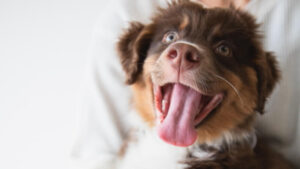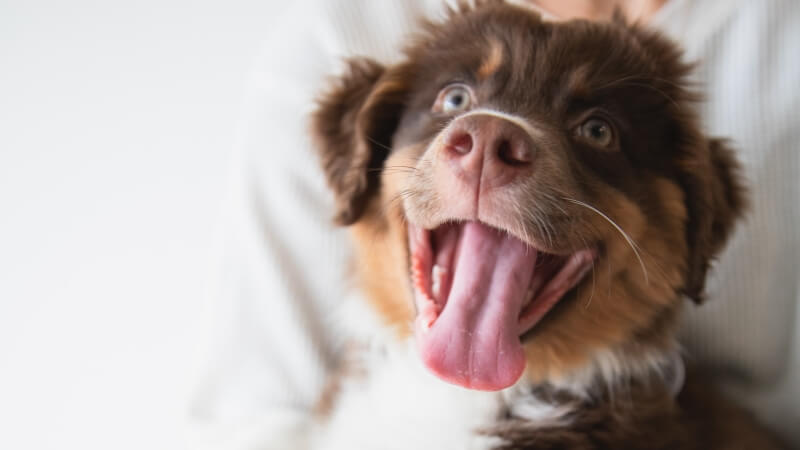
Dog Puzzle Feeder vs Interactive Toys: Which Is Best For Your Pooch?
Choosing the right plaything for your furry friend – be it a dog puzzle feeder or interactive toys – is essential for their mental and

Are you constantly asking yourself, “how to stop your dog from chewing on furniture“? It’s a common challenge for dog owners, but there’s hope! With the right strategies, you can teach your furry friend to leave your furniture alone and chew on more appropriate items.
This guide will take you through a series of steps and tips to help you and your dog overcome this hurdle.
Unraveling the reasons behind your dog’s chewing habits is the first step towards finding a solution.
Puppyhood is a critical time when young dogs experience teething. This natural phase causes discomfort in their gums, prompting them to chew on almost anything, including furniture.
It’s a way for them to alleviate the pain and explore their environment. During this period, providing suitable chew toys can help redirect their need to chew away from your furniture.
Dogs often resort to chewing as a coping mechanism for boredom or anxiety. Lack of sufficient physical and mental stimulation can lead to this destructive behavior.
It’s essential to ensure that your dog has enough exercise, playtime, and mental challenges to keep them engaged and prevent them from turning to your furniture as a source of entertainment or stress relief.
Sometimes the root of the problem is simply a lack of understanding. Dogs might not naturally know that furniture is off-limits for chewing. This is where consistent and clear training comes into play. By teaching your dog what is acceptable to chew and what is not, you can prevent a lot of unwanted behavior.
Dogs are curious creatures, and their playful nature often leads them to explore their environment through their mouths. Chewing on furniture might be a part of this exploration.
Understanding this aspect of your dog’s behavior can help you provide better alternatives that satisfy their curiosity more appropriately.
Prevention is key when it comes to protecting your furniture from your dog’s chewing habits.
A well-exercised dog is less likely to engage in unwanted behaviors like furniture chewing. Regular walks, play sessions, and engaging activities are crucial for keeping your dog physically active and mentally stimulated. An engaged and tired dog is much less likely to turn to destructive behaviors out of boredom or excess energy.
It’s important to provide a variety of chew toys that are appealing and safe for your dog. These toys can satisfy their natural chewing instincts and keep them away from your furniture.
Rotate the toys regularly to keep your dog interested and engaged, and make sure the toys are durable and appropriate for your dog’s size and chewing strength.
Designating a dog-safe area in your home where your dog can play and relax without the temptation of furniture can be very effective.
This area should be comfortable and filled with their toys and bedding, creating a positive environment where they can enjoy their time without causing any damage.
Bitter sprays can be a helpful deterrent for dogs that chew on furniture. These non-toxic sprays have an unpleasant taste that discourages dogs from chewing on treated surfaces. Remember to regularly reapply the spray and test it on a small area first to ensure it doesn’t damage the furniture.
Training is the cornerstone of changing your dog’s furniture-chewing habits.
Positive reinforcement is one of the most effective training methods. Rewarding your dog for good behavior, such as chewing on their toys instead of furniture, reinforces the behavior you want to see.
Use treats, praise, or their favorite toy as a reward. This method builds a positive association with the desired behavior and encourages its repetition.
Clear boundaries and rules help your dog understand what is expected of them. If furniture chewing is not allowed, be consistent in enforcing this rule.
Use barriers or keep certain rooms off-limits if necessary. Consistent rules and boundaries help your dog learn faster and understand what behaviors are acceptable in your home.
Whenever you catch your dog chewing on furniture, calmly interrupt them and redirect their attention to a chew toy or bone. This teaches them what is acceptable to chew on. Be immediate and consistent with this redirection to help them learn the correct behavior.
Being consistent in your training and responses is vital for your dog’s learning process. Consistency in rules, commands, and your reactions to their behavior helps your dog understand and adhere to the desired behavior. Inconsistent responses can confuse your dog and delay their learning.
When you catch your dog chewing furniture, the way you handle the situation is crucial.
Immediate and appropriate correction is key when you catch your dog chewing on furniture. Calmly interrupt their behavior and offer them an alternative, like a chew toy. A firm “no” or “leave it” command can be effective, but it should always be followed up with positive redirection.
Negative reactions, such as yelling or physical punishment, can be harmful and counterproductive. These responses can increase anxiety and may exacerbate chewing behavior. Instead, focus on teaching and guiding your dog towards the behavior you want to see.
Teaching your dog commands like “leave it” or “no chew” can be very effective in managing their chewing behavior. Use these commands consistently to intervene when they start to chew on furniture.
Consistent use of commands, combined with positive reinforcement when they obey, helps your dog understand and comply with your instructions.
In some cases, professional guidance is needed to address more challenging behavior.
If you find yourself struggling to manage your dog’s furniture-chewing behavior, it might be time to seek advice from a professional.
A dog trainer or canine behaviorist can assess your dog’s behavior and provide personalized training strategies. They can also offer insights into your dog’s behavior that you might not have considered.
Obedience classes can be an excellent resource for both you and your dog. These classes teach basic commands and good behavior, and they also provide an opportunity for socialization.
Your dog can learn to interact with other dogs and people in a controlled environment, which can help reduce anxiety and boredom, leading to less destructive behavior at home.
Maintaining and adjusting your approach is essential for long-term success in managing your dog’s behavior.
Regularly assess your dog’s progress and behavior to ensure that your strategies are effective. Be prepared to adjust your approach based on your dog’s response. Regular assessments can help you identify any new or recurring issues and address them promptly.
As your dog grows and their environment changes, their needs and behaviors might change as well. Be flexible and ready to adapt your strategies to these changes. This might include introducing new toys, changing up their exercise routine, or revisiting training techniques.
In conclusion, addressing the issue of how to stop your dog from chewing on furniture requires a combination of understanding, preventive measures, consistent training, and adaptation to your dog’s changing needs. Remember, patience and persistence are key in this journey.
Incorporating engaging toys like puzzle feeders can also offer additional mental stimulation, helping to further reduce the likelihood of your dog turning to furniture for entertainment. With dedication and the right approach, you can successfully guide your dog away from unwanted chewing habits.


Choosing the right plaything for your furry friend – be it a dog puzzle feeder or interactive toys – is essential for their mental and

Wondering if a puzzle feeder could revolutionize your pet’s mealtime into an exciting challenge? This unique device promises to engage your furry friend both mentally

For passionate pet enthusiasts, a puzzle feeder is more than just a toy; it’s a critical tool for mental stimulation and dietary control for their

Are you ready to dive deeper into the world of puzzle feeder and embark on a journey to ensure your furry friends remain mentally stimulated?

Choosing the right plaything for your furry friend – be it a dog puzzle feeder or interactive toys – is essential for their mental and

Wondering if a puzzle feeder could revolutionize your pet’s mealtime into an exciting challenge? This unique device promises to engage your furry friend both mentally

For passionate pet enthusiasts, a puzzle feeder is more than just a toy; it’s a critical tool for mental stimulation and dietary control for their

Are you ready to dive deeper into the world of puzzle feeder and embark on a journey to ensure your furry friends remain mentally stimulated?
Copyright © 2024 puppypuzzlefeeder. All Rights Reserved.